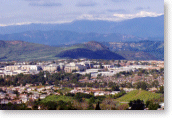 Nestled within a picturesque plateau surrounded by tree-dotted hills and scenic mountains, the City of Thousand Oaks is situated in the southeastern edge of Ventura County adjoining the western edge of Los Angeles County in the Conejo Valley. More specifically, it is located 12 miles inland from the Pacific Ocean, 39 miles west of Los Angeles, and 24 miles southeast of Port Hueneme, the only deepwater harbor between Los Angeles and San Francisco. The mountains, hills, and plateau that make up Conejo Valley are a geologic record of the Precambrian past which carved the California landscape into what it is today. Over millions of years, powerful earthquakes and other natural forces of fire, ice, wind and water moved landmasses, and sculpted mountains, valleys, riverbeds, lakes, and canyons. What is now Ventura County was once under the ocean, with volcanoes rising above the water's surface. Seashells and other marine fossils can still be found embedded in the local hills.
Nestled within a picturesque plateau surrounded by tree-dotted hills and scenic mountains, the City of Thousand Oaks is situated in the southeastern edge of Ventura County adjoining the western edge of Los Angeles County in the Conejo Valley. More specifically, it is located 12 miles inland from the Pacific Ocean, 39 miles west of Los Angeles, and 24 miles southeast of Port Hueneme, the only deepwater harbor between Los Angeles and San Francisco. The mountains, hills, and plateau that make up Conejo Valley are a geologic record of the Precambrian past which carved the California landscape into what it is today. Over millions of years, powerful earthquakes and other natural forces of fire, ice, wind and water moved landmasses, and sculpted mountains, valleys, riverbeds, lakes, and canyons. What is now Ventura County was once under the ocean, with volcanoes rising above the water's surface. Seashells and other marine fossils can still be found embedded in the local hills.
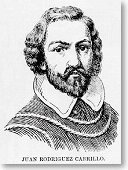 Evidence indicates that the first native inhabitants of present-day Ventura County date back 7,000 years and were called the Oak Grove people. The tribes later known as the Chumash moved into the region approximately 3,000 years ago and established more than 40 villages. These Native Americans lived by harvesting grains and acorns, and hunting rabbits, boar, deer and other game. The area's recorded history dates back to 1542 when the Portuguese explorer Juan Rodriguez Cabrillo (a few historians maintain he was Spanish) explored the west coast of North America and present-day California while sailing for Spain. He was the first European to navigate the coast of Alta California, and anchored in several harbors from San Diego to Point Conception. He claimed the land for the King of Spain by placing his country's flag at Point Mugu. For the next two and a half centuries, the region remained essentially undisturbed until Spanish explorers and missionaries arrived.
Evidence indicates that the first native inhabitants of present-day Ventura County date back 7,000 years and were called the Oak Grove people. The tribes later known as the Chumash moved into the region approximately 3,000 years ago and established more than 40 villages. These Native Americans lived by harvesting grains and acorns, and hunting rabbits, boar, deer and other game. The area's recorded history dates back to 1542 when the Portuguese explorer Juan Rodriguez Cabrillo (a few historians maintain he was Spanish) explored the west coast of North America and present-day California while sailing for Spain. He was the first European to navigate the coast of Alta California, and anchored in several harbors from San Diego to Point Conception. He claimed the land for the King of Spain by placing his country's flag at Point Mugu. For the next two and a half centuries, the region remained essentially undisturbed until Spanish explorers and missionaries arrived.
In the early 1800s, a Spanish governor granted 48,671 acres of land to two loyal soldiers. One of these land grants, Rancho Conejo, included the area that became known as the Conejo Valley. It was within this “Valley of Rabbits”
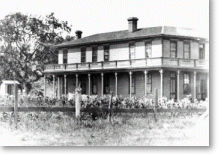 that the City of Thousand Oaks would later be established. During the half-century that followed, vaqueros roamed the valley and tended great herds of cattle. In the late 1800s, the valley began to be parceled into ranchos, and in 1875, early pioneers opened a post office. In 1876, the historic Grand Union Hotel (also called El Hotel Grande and eventually Stagecoach Inn) was constructed with Northern California redwood at a cost of approximately $7,200. The redwood lumber was transported by sea and was freighted up the steep Conejo Grade (between Thousand Oaks and Camarillo) by multi-team wagons.
that the City of Thousand Oaks would later be established. During the half-century that followed, vaqueros roamed the valley and tended great herds of cattle. In the late 1800s, the valley began to be parceled into ranchos, and in 1875, early pioneers opened a post office. In 1876, the historic Grand Union Hotel (also called El Hotel Grande and eventually Stagecoach Inn) was constructed with Northern California redwood at a cost of approximately $7,200. The redwood lumber was transported by sea and was freighted up the steep Conejo Grade (between Thousand Oaks and Camarillo) by multi-team wagons.
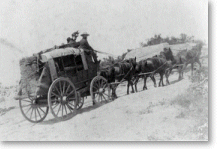 Built by James Hammell, a Santa Barbara businessman, the hotel was fashioned in the Monterey style and featured two stories with a wraparound porch and balcony. It was originally located at the southwest corner of what is now Ventu Park Road and the Ventura Freeway, approximately 200 yards to the north of its present location. Publicized as a pleasure resort by a local Ventura newspaper, the Stagecoach Inn became a stop on the stagecoach route between Los Angeles and Santa Barbara. Because stagecoaches continued to make their way through the Conejo Valley well into the late 1800's, many hotel guests arrived via this means of transportation.
Built by James Hammell, a Santa Barbara businessman, the hotel was fashioned in the Monterey style and featured two stories with a wraparound porch and balcony. It was originally located at the southwest corner of what is now Ventu Park Road and the Ventura Freeway, approximately 200 yards to the north of its present location. Publicized as a pleasure resort by a local Ventura newspaper, the Stagecoach Inn became a stop on the stagecoach route between Los Angeles and Santa Barbara. Because stagecoaches continued to make their way through the Conejo Valley well into the late 1800's, many hotel guests arrived via this means of transportation.
After passing through several owners, the hotel was purchased in 1885 by Cecil Haigh, an Englishman. From 1887 to 1901, the hotel served as a regular depot for the Coast Stage Line, which carried both passengers and mail. During its existence, the Stagecoach Inn functioned in a variety of ways including post office, tearoom, boys' military school, restaurant, and exclusive gift shop. In the 1930s, it served as a film locale for Roaring Ranch (1930), a B-Western starring Hoot Gibson and Sally Eilers. Throughout the years, the changes to the Stagecoach Inn's external appearance depended on its current function and who was leasing the property.
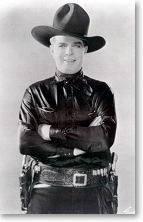 With the invention of the “horseless carriage” and the construction of a highway between Los Angeles and San Francisco, the Conejo Valley began to evolve. In the mid-1960s, the Inn was threatened with demolition by the expansion of the Ventura Freeway. The Conejo Valley Historical Society (CVHS) was formed in order to save the building, and in 1965 was successful in declaring the Stagecoach Inn a California Landmark (No. 659). H. Allen Hays, grandson of Cecil Haigh, gave the building and approximately four acres of land (present location) to the CVHS. The CVHS later deeded the property to the Conejo Recreation and Park District in return for a 50-year renewable lease to operate the facilities for cultural and educational purposes. In 1966, the Stagecoach Inn was moved to its present location, and with the help of community volunteers and the historical society began operating as a museum. Tragically, in April 1970, a fire of undetermined origin completely destroyed the museum and most of its contents. It was rebuilt to appear as it did when it was originally constructed. Although the reconstructed museum was dedicated and reopened on July 4, 1976, the second floor remained incomplete until 1980. Today, the Inn consists of the museum, a replica of the Timber School (originally built in 1899), the barn, a nature trail, and the Tri-Village, a small group of three houses: the pioneer house, the adobe, and the Chumash village. A gift shop is also located inside the museum.
With the invention of the “horseless carriage” and the construction of a highway between Los Angeles and San Francisco, the Conejo Valley began to evolve. In the mid-1960s, the Inn was threatened with demolition by the expansion of the Ventura Freeway. The Conejo Valley Historical Society (CVHS) was formed in order to save the building, and in 1965 was successful in declaring the Stagecoach Inn a California Landmark (No. 659). H. Allen Hays, grandson of Cecil Haigh, gave the building and approximately four acres of land (present location) to the CVHS. The CVHS later deeded the property to the Conejo Recreation and Park District in return for a 50-year renewable lease to operate the facilities for cultural and educational purposes. In 1966, the Stagecoach Inn was moved to its present location, and with the help of community volunteers and the historical society began operating as a museum. Tragically, in April 1970, a fire of undetermined origin completely destroyed the museum and most of its contents. It was rebuilt to appear as it did when it was originally constructed. Although the reconstructed museum was dedicated and reopened on July 4, 1976, the second floor remained incomplete until 1980. Today, the Inn consists of the museum, a replica of the Timber School (originally built in 1899), the barn, a nature trail, and the Tri-Village, a small group of three houses: the pioneer house, the adobe, and the Chumash village. A gift shop is also located inside the museum.
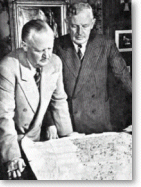 In the early 1900s, the Janss family, developers of several Southern California subdivisions including Monterey Park, the San Fernando Valley, and Westwood Village, purchased 10,000 acres of farmland in the Conejo Valley (see Janss Conejo Ranch) from the heirs of John Edwards. The Janss family was headed by Peter Janss, who had emigrated from Denmark in 1870. After becoming a physician, he moved from Chicago to Los Angeles in 1893 and became a land developer. His two sons, Harold and Edwin, eventually joined him in business. In 1931, Peter Janss built the Janss House in the Conejo Valley as a weekend retreat; in 1943 it became the principal home of Janss' younger son, Edwin Janss. The Janss House was designated a County Historical Landmark in July 1987, and today is owned by the City of Thousand Oaks and houses the Arts Council.
In the early 1900s, the Janss family, developers of several Southern California subdivisions including Monterey Park, the San Fernando Valley, and Westwood Village, purchased 10,000 acres of farmland in the Conejo Valley (see Janss Conejo Ranch) from the heirs of John Edwards. The Janss family was headed by Peter Janss, who had emigrated from Denmark in 1870. After becoming a physician, he moved from Chicago to Los Angeles in 1893 and became a land developer. His two sons, Harold and Edwin, eventually joined him in business. In 1931, Peter Janss built the Janss House in the Conejo Valley as a weekend retreat; in 1943 it became the principal home of Janss' younger son, Edwin Janss. The Janss House was designated a County Historical Landmark in July 1987, and today is owned by the City of Thousand Oaks and houses the Arts Council.
Construction of the first local highway made it possible for Los Angeles residents to drive to the picturesque Conejo Valley countryside dotted with field crops, orchards, chicken, hog, and dairy farms. As a result, more settlers arrived,
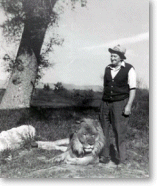 as well as tourists who flocked to the area to see jungle animals performing at Louis Goebel's Lion Farm. Located on the southwest corner of Thousand Oaks Boulevard and Conejo School Road, Goebel's Lion Farm opened to the public in 1927 and was later called Jungleland (see Goebel's Jungleland). Soon the motion picture industry also discovered Conejo Valley's scenic beauty. Filming in the Conejo Valley has mainly been done in five principal locales: Thousand Oaks, Janss Conejo Ranch (a portion of which has been preserved as Wildwood Park), Lake Sherwood, Hidden Valley, and to a lesser degree Russell Ranch (see Westlake Village). Big screen productions with scenes filmed in this locale include D.W. Griffith's The Birth of a Nation (1915), Allan Dwan's Robin Hood (1922), Frank Capra's It Happened One Night (1934), Cedric Gibbons' Tarzan and His Mate (1934), Michael Curtiz' The Charge of the Light Brigade (1936) and The Adventures of Robin Hood (1938), William Wyler's Wuthering Heights (1939), Raoul Walsh's Desperate Journey (1942), Fred M. Wilcox's
as well as tourists who flocked to the area to see jungle animals performing at Louis Goebel's Lion Farm. Located on the southwest corner of Thousand Oaks Boulevard and Conejo School Road, Goebel's Lion Farm opened to the public in 1927 and was later called Jungleland (see Goebel's Jungleland). Soon the motion picture industry also discovered Conejo Valley's scenic beauty. Filming in the Conejo Valley has mainly been done in five principal locales: Thousand Oaks, Janss Conejo Ranch (a portion of which has been preserved as Wildwood Park), Lake Sherwood, Hidden Valley, and to a lesser degree Russell Ranch (see Westlake Village). Big screen productions with scenes filmed in this locale include D.W. Griffith's The Birth of a Nation (1915), Allan Dwan's Robin Hood (1922), Frank Capra's It Happened One Night (1934), Cedric Gibbons' Tarzan and His Mate (1934), Michael Curtiz' The Charge of the Light Brigade (1936) and The Adventures of Robin Hood (1938), William Wyler's Wuthering Heights (1939), Raoul Walsh's Desperate Journey (1942), Fred M. Wilcox's
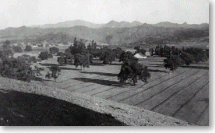 Lassie Come Home (1943), Edward Dmytryk's Back to Bataan (1945), Walter Lang's State Fair (1945), Jacques Tourneur's Out of the Past (1947), Allan Dwan's Sands of Iwo Jima (1949), John Ford's When Willie Comes Marching Home (1950) and Stanley Kubrick's Spartacus (1960). More recent movies that have been filmed in this region include Demolition Man (1993), Doctor Dolittle (1998), Star Trek: Insurrection (1998), American Pie (1999), Cruel Intentions (1999), Picture Perfect (2002), The Sisters Club (2002), Shiner (2004), and Memoirs of a Geisha (2005). Today, the entertainment industry continues to utilize the Thousand Oaks area for movies, television, and commercials.
Lassie Come Home (1943), Edward Dmytryk's Back to Bataan (1945), Walter Lang's State Fair (1945), Jacques Tourneur's Out of the Past (1947), Allan Dwan's Sands of Iwo Jima (1949), John Ford's When Willie Comes Marching Home (1950) and Stanley Kubrick's Spartacus (1960). More recent movies that have been filmed in this region include Demolition Man (1993), Doctor Dolittle (1998), Star Trek: Insurrection (1998), American Pie (1999), Cruel Intentions (1999), Picture Perfect (2002), The Sisters Club (2002), Shiner (2004), and Memoirs of a Geisha (2005). Today, the entertainment industry continues to utilize the Thousand Oaks area for movies, television, and commercials.
The area's rural appearance with its rolling hills and pastures, as well as its relative proximity to Hollywood, made it an ideal backdrop for the popular Western genre of the 1930s, ’40s, and ’50s. A-Westerns filmed here include
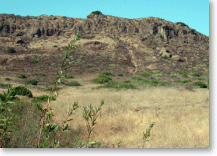 The Man from Dakota (1940) starring Wallace Beery and John Howard, Virginia City (1940) starring Errol Flynn and Miriam Hopkins, Tall in the Saddle (1944) starring John Wayne and Ella Raines, The Nevadan (1950) starring Randolph Scott and Dorothy Malone, Man in the Saddle (1951) starring Randolph Scott and Joan Leslie, The Duel at Silver Creek (1952) starring Audie Murphy and Stephen McNally, The Lawless Breed (1953) starring Rock Hudson and Julia Adams, Davy Crockett, King of the Wild Frontier (1954) starring Fess Parker and Buddy Ebsen, Destry (1954) starring Audie Murphy and Mari Blanchard, The Man from Bitter Ridge (1955) starring Lex Barker and Mara Corday, Man Without a Star (1955) starring Kirk Douglas and Jeanne Crain, Tall Man Riding (1955) starring Randolph Scott and Dorothy Malone, The Lone Ranger (1956) starring Clayton Moore and Jay Silverheels, Red Sundown (1956) starring Rory Calhoun and Martha Hyer, Gunsight Ridge (1957) starring Joel McCrea and Mark Stevens, The Saga of Hemp Brown (1958)
The Man from Dakota (1940) starring Wallace Beery and John Howard, Virginia City (1940) starring Errol Flynn and Miriam Hopkins, Tall in the Saddle (1944) starring John Wayne and Ella Raines, The Nevadan (1950) starring Randolph Scott and Dorothy Malone, Man in the Saddle (1951) starring Randolph Scott and Joan Leslie, The Duel at Silver Creek (1952) starring Audie Murphy and Stephen McNally, The Lawless Breed (1953) starring Rock Hudson and Julia Adams, Davy Crockett, King of the Wild Frontier (1954) starring Fess Parker and Buddy Ebsen, Destry (1954) starring Audie Murphy and Mari Blanchard, The Man from Bitter Ridge (1955) starring Lex Barker and Mara Corday, Man Without a Star (1955) starring Kirk Douglas and Jeanne Crain, Tall Man Riding (1955) starring Randolph Scott and Dorothy Malone, The Lone Ranger (1956) starring Clayton Moore and Jay Silverheels, Red Sundown (1956) starring Rory Calhoun and Martha Hyer, Gunsight Ridge (1957) starring Joel McCrea and Mark Stevens, The Saga of Hemp Brown (1958)
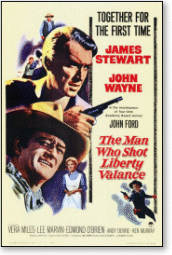 starring Rory Calhoun and Beverly Garland, Wild Heritage (1958) starring Will Rogers, Jr. and Maureen O'Sullivan, Flaming Star (1960) starring Elvis Presley and Barbara Eden, The Man Who Shot Liberty Valance (1962) starring James Stewart and John Wayne, Shenandoah (1965) starring James Stewart and Doug McClure, Firecreek (1968) starring James Stewart and Henry Fonda, Death of a Gunfighter (1969) starring Richard Widmark and Lena Horne, The Good Guys and the Bad Guys (1969) starring Robert Mitchum and George Kennedy, and Little Big Man (1970) starring Dustin Hoffman and Faye Dunaway. B-Westerns filmed in the Conejo Valley include such horse operas as Come On, Tarzan (1932), Destry Rides Again (1932), The Last of the Mohicans (1932), Dude Cowboy (1941), Riding the Wind (1942), Lights of Old Santa Fe (1944), San Fernando Valley (1944), Song of Nevada (1944), My Pal Trigger (1946), Under Nevada Skies (1946), The Vigilante (1947), The Gay Ranchero (1948), Riders of the Whistling Pines (1949), and Sons of New Mexico (1949). The area has also been used extensively for television, especially in some of the most popular long-running Westerns of the late 1950s and 1960s such as Wagon Train, The Rifleman, Bonanza, Laramie, The Big Valley, and Dundee and the Culhane. Others television shows that feature this locale include Combat!, Green Acres, and more recently 100 Deeds for Eddie McDowd.
starring Rory Calhoun and Beverly Garland, Wild Heritage (1958) starring Will Rogers, Jr. and Maureen O'Sullivan, Flaming Star (1960) starring Elvis Presley and Barbara Eden, The Man Who Shot Liberty Valance (1962) starring James Stewart and John Wayne, Shenandoah (1965) starring James Stewart and Doug McClure, Firecreek (1968) starring James Stewart and Henry Fonda, Death of a Gunfighter (1969) starring Richard Widmark and Lena Horne, The Good Guys and the Bad Guys (1969) starring Robert Mitchum and George Kennedy, and Little Big Man (1970) starring Dustin Hoffman and Faye Dunaway. B-Westerns filmed in the Conejo Valley include such horse operas as Come On, Tarzan (1932), Destry Rides Again (1932), The Last of the Mohicans (1932), Dude Cowboy (1941), Riding the Wind (1942), Lights of Old Santa Fe (1944), San Fernando Valley (1944), Song of Nevada (1944), My Pal Trigger (1946), Under Nevada Skies (1946), The Vigilante (1947), The Gay Ranchero (1948), Riders of the Whistling Pines (1949), and Sons of New Mexico (1949). The area has also been used extensively for television, especially in some of the most popular long-running Westerns of the late 1950s and 1960s such as Wagon Train, The Rifleman, Bonanza, Laramie, The Big Valley, and Dundee and the Culhane. Others television shows that feature this locale include Combat!, Green Acres, and more recently 100 Deeds for Eddie McDowd.
By the mid-20th century, the Janss Corporation had begun planning a “total community.” Within a decade, there were two shopping centers, an industrial park, schools, churches, and a four-year liberal arts college to entice increasingly
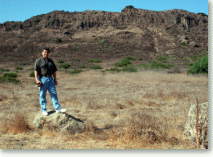 more residents to this rural development. Evidenced by the high visibility of the Janss' name throughout the valley, these developers left a positive impression on this community. On September 29, 1964, the community voted to incorporate as the City of Thousand Oaks, honoring the abundant, majestic oak trees in the area. In the first years after incorporation, nearly 20,000 people lived within the 14.28 square miles of the newly-drawn city boundaries. As a planned community, the City of Thousand Oaks integrated controlled growth and a balanced mix of residential areas, modern shopping centers, schools, business and industrial centers, parks and open spaces.
more residents to this rural development. Evidenced by the high visibility of the Janss' name throughout the valley, these developers left a positive impression on this community. On September 29, 1964, the community voted to incorporate as the City of Thousand Oaks, honoring the abundant, majestic oak trees in the area. In the first years after incorporation, nearly 20,000 people lived within the 14.28 square miles of the newly-drawn city boundaries. As a planned community, the City of Thousand Oaks integrated controlled growth and a balanced mix of residential areas, modern shopping centers, schools, business and industrial centers, parks and open spaces.
 In the beautiful ranch-filled Hidden Valley south of Thousand Oaks is the newly developed residential community Sherwood Valley. Developed by David Murdock, this peaceful rural setting with gate-guarded privacy is only forty minutes from the hustle and bustle of Los Angeles. Sherwood Valley, made up of Lake Sherwood and its surrounding 1,900 exclusive acres, is home to millionaires and movie stars and speckled with expansive homes, a magnificent country club, and includes a Jack Nicklaus Championship Golf Course. Prior to the mid-1950s, Lake Sherwood and its surroundings were often frequented by Hollywood's filmmakers who used this location as a backdrop for a wide variety of films including several action serials (see Lake Sherwood).
In the beautiful ranch-filled Hidden Valley south of Thousand Oaks is the newly developed residential community Sherwood Valley. Developed by David Murdock, this peaceful rural setting with gate-guarded privacy is only forty minutes from the hustle and bustle of Los Angeles. Sherwood Valley, made up of Lake Sherwood and its surrounding 1,900 exclusive acres, is home to millionaires and movie stars and speckled with expansive homes, a magnificent country club, and includes a Jack Nicklaus Championship Golf Course. Prior to the mid-1950s, Lake Sherwood and its surroundings were often frequented by Hollywood's filmmakers who used this location as a backdrop for a wide variety of films including several action serials (see Lake Sherwood).
From its inception, Thousand Oaks has been dedicated to preserving and maintaining its scenic and natural resources. City administration and planning is accomplished by an elected 5-member City Council with an appointed City Manager, along with extensive community involvement. Because of its commitment to offering the finest quality community services to its residents and businesses, Thousand Oaks has earned recognition as one of the safest cities of its size in the nation and one of the top ten communities for statewide academic achievement.
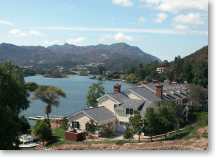 Having grown to 56 square miles with approximately 121,000 residents, the city has received awards for its more than 2,500 annual organized recreation programs conducted within 42 developed parks, 5 playfields, 7 community centers, and 1 large district central park. Thousand Oaks also maintains the 1,750-acre Wildwood Park, 15,000 acres of open space, and 110 miles of trails. This preserved space allows residents to enjoy the same natural beauty that the Chumash Native Americans first enjoyed hundreds of years ago. City officials remain proud of the city's past and present, and are dedicated to offering a quality suburban lifestyle within a beautiful natural setting. The City of Thousand Oaks is conveniently located approximately halfway between Santa Barbara and Los Angeles on the US Highway 101.
Having grown to 56 square miles with approximately 121,000 residents, the city has received awards for its more than 2,500 annual organized recreation programs conducted within 42 developed parks, 5 playfields, 7 community centers, and 1 large district central park. Thousand Oaks also maintains the 1,750-acre Wildwood Park, 15,000 acres of open space, and 110 miles of trails. This preserved space allows residents to enjoy the same natural beauty that the Chumash Native Americans first enjoyed hundreds of years ago. City officials remain proud of the city's past and present, and are dedicated to offering a quality suburban lifestyle within a beautiful natural setting. The City of Thousand Oaks is conveniently located approximately halfway between Santa Barbara and Los Angeles on the US Highway 101.